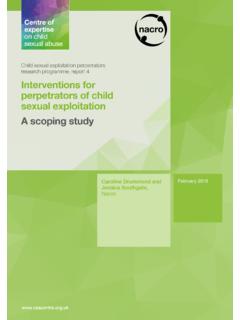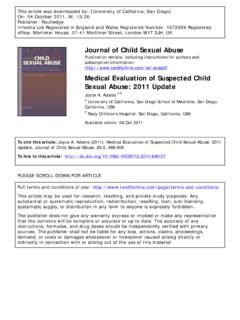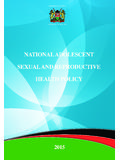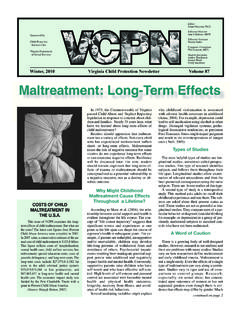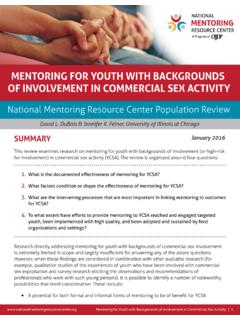Transcription of Developmental effects of exposure to Intimate …
1 Children and Youth Services review 31 (2009) 831 839. Contents lists available at ScienceDirect Children and Youth Services review j o u r n a l h o m e p a g e : w w w. e l s ev i e r. c o m / l o c a t e / c h i l d yo u t h Developmental effects of exposure to Intimate partner violence in early childhood: a review of the literature Georgia L. Carpenter, Ann M. Stacks . Merrill-Palmer Skillman Institute, Wayne State University, United States a r t i c l e i n f o a b s t r a c t Article history: Intimate partner violence (IPV) is a prevalent social problem in the United States and women of childbearing Received 5 October 2008 age are the most likely victims.
2 The young children born to these women are impacted, however, women are Received in revised form 13 March 2009 not routinely asked about IPV even when there is evidence that their child has been abused. To highlight the Accepted 17 March 2009. importance of routinely screening for IPV in child welfare and other social service agencies this article Available online 25 March 2009. reviews typical social-emotional development and physiological/neurological development in early child- Keywords: hood and the impact that IPV and trauma have on these domains of development.
3 Early intervention with Intimate partner violence young children and caregivers living with IPV provides a signi cant buffer to the negative effects that Trauma witnessing IPV have on children's development and their relationships with caregivers. Infant 2009 Elsevier Ltd. All rights reserved. Development 1. Introduction reported that almost half of all incidents of IPV occurred in homes with a child under the age of twelve, re ecting approximately The Family violence Prevention Fund (2008) de nes Intimate 297,435 children in one year who were exposed to IPV.
4 This estimate partner violence (IPV) as physical, sexual or psychological harm by may be lower than the actual number of children who witness IPV. a current or former Intimate partner or spouse; it includes a pattern Straus (1979) believed that more than ten million children a year are of coercive or manipulative behaviors perpetrated by one Intimate exposed to domestic violence in the United States. Younger children partner against the other in order to gain or maintain control in the are most likely to witness domestic violence and children under the relationship.
5 These behaviors include psychological, verbal, nancial, age of 6 are at a higher risk than older children for exposure to IPV. physical and/or sexual abuse concurrently or alone. Some examples of (Fantuzzo, Boruch, Beriama, & Atkins, 1997; Gjelsvik, Verhoek- common tactics used by male or female Intimate partners to control Oftedahl, & Pearlman, 2003). If one considers that IPV often rst their partners include isolating their partners from friends or family, occurs during pregnancy (Family violence Prevention Fund, 2008). taking their partner 's money and giving an allowance without the number of children affected at a very young age is even larger.
6 In consulting their partners, demeaning their partner in front of friends, addition to being more likely to witness IPV, children under the age of or the threat of or actual physical or sexual assaults. 3 years are also more likely than older children to experience abuse IPV is a prevalent social problem in the United States; approxi- and neglect, which is also a risk factor for witnessing IPV (Mof tt &. mately 44% of women experience domestic violence in their lifetime Caspi, 1998; Borrego, Gutow, Reichert, & Barker, 2008); Research by (Thompson et al., 2006).
7 While the rates of IPV reported by women Edelson (1999) suggests that between 30% and 60% of families who seem high, the actual numbers are most likely higher since the are served by child welfare agencies also experience IPV. statistics are based on reported cases which tend to be lower than the total number of victimizations (Rennison, 2003). Young women between the ages of 16 and 24 years appear to be at the greatest risk Screening for IPV. for experiencing IPV (Rennison, 2003; Thompson et al., 2006). In the United States, state child protection agencies de ne child exposure to IPV as a form of child abuse by commission or neglect Risk factors for exposure to IPV by omission (De Bellis et al.)
8 , 2002).Despite this and the large numbers of children exposed to IPV, less than half ( ) of child welfare Research suggests that many young children are witnessing IPV agencies report that they assess 100% of all of the families who are (Borrego, Gutow, Reichert, & Barker, 2008; Gjelsvik, Verhoek-Oftedahl, referred to them and that most referrals take place at investigation. & Pearlman, 2003; Rennison, 2003). For example, Rennison (2003) (Hazen et al., 2007). When IPV is discovered by child welfare agencies, services or referrals to address the violence are not always initiated.
9 Corresponding author. Bowker, Arbitell, and McFerron (1988) found that less than 10% of the E-mail address: ( Stacks). time when IPV was occurring in a child welfare case, the caseworker 0190-7409/$ see front matter 2009 Elsevier Ltd. All rights reserved. 832 Carpenter, Stacks / Children and Youth Services review 31 (2009) 831 839. did the following: arranged for transportation to a safe place, referred Dozier, Higley, Albus, & Nutter, 2002). Almost all infants will form children to services related to their witnessing of violent acts, an attachment with one or a small number of caregivers by 10 to provided written material on IPV or helped the victim obtain an 12 months of age (Sroufe, 2000).
10 Ainsworth, Blehar, Waters, and Wall order of protection. (1978) suggest that the way in which mothers respond to their infants There is a perception that infants and young children are not as is associated with the quality of the attachment relationship with affected by witnessing IPV as older children. However, evidence three patterns of attachment relationships: secure, which is con- suggests that young infants can be affected more intensely by sidered the most optimal, and two less optimal insecure patterns of exposure to this trauma than previously believed (Cassidy & Mohr, attachment, insecure-avoidant, and insecure-ambivalent or resistant.)



